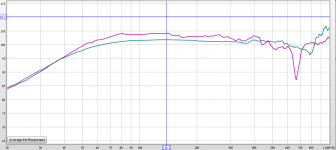Hello, i have 9" midwoofer that i measured few centimetres distance distance in free air and in cabinet,
as you can see there is something weird going on at 450hz-850hz when the midwoofer is in a cabinet (sealed), i have 2 cabinets i have tested them with, both should an ideal size so the problem is not there.
I have both of these models and they do the same problem.
http://www.sievers-audio.de/chassisdaten_m/mw265.pdf
http://www.europe-audio.com/datasheets\morel\mw267.pdf
so trying to figure out if i can and how to fix this problem.
as you can see there is something weird going on at 450hz-850hz when the midwoofer is in a cabinet (sealed), i have 2 cabinets i have tested them with, both should an ideal size so the problem is not there.
I have both of these models and they do the same problem.
http://www.sievers-audio.de/chassisdaten_m/mw265.pdf
http://www.europe-audio.com/datasheets\morel\mw267.pdf
so trying to figure out if i can and how to fix this problem.
Attachments
Well, if I see the graphs in the datasheets you provided it looks like it matches your findings quite well...
What are your intentions of using a 9 inch woofer that high?
What are your intentions of using a 9 inch woofer that high?
that dip shouldn't start before 700hz, was fine if it started like the free air measurement as well.
Crossing it with 3" dome midrange so the plan is 500hz~700hz of crossing point, and as you can see the 850hz and above gets amplified while the 450-850hz suffers, which makes an annoying overlapping unless i choose to just leave that area -5DB, which isnt very ideal for me.
The original plan was 1st order crossover, which is what the company originally did, but even with higher order i still stay with a big null somewhere in the best case.
Crossing it with 3" dome midrange so the plan is 500hz~700hz of crossing point, and as you can see the 850hz and above gets amplified while the 450-850hz suffers, which makes an annoying overlapping unless i choose to just leave that area -5DB, which isnt very ideal for me.
The original plan was 1st order crossover, which is what the company originally did, but even with higher order i still stay with a big null somewhere in the best case.
Last edited:
if cabinet size is relevant then they have somewhere around 45L and 20L cabinets (not sure whats the exact number)
I was thinking of making phase plug for the woofer, from little testing it seems like it gives a good off-axis results as well ,and doesn't rise the overall distortion by much, is there something else i should be aware of or plug phase when crossed low enough like in my case shouldn't give me any big disadvantages?
Last edited:
A close mic measurement of the driver ( 1/4" from the driver center ) should correspond well to the factory curves.
Diffraction from the enclosure may be visible in the measurement. Here's a bit of reading on diffraction: True Audio TechTopics: Diffraction Loss
Diffraction from the enclosure may be visible in the measurement. Here's a bit of reading on diffraction: True Audio TechTopics: Diffraction Loss
Quick question.... What is this thread doing in the Full Range section?
And I don't see any big problems there. Looks like you have internal reflections in your cabinet that is messing up the FR. Brace and add stuffing to the cabinet, and move this to the Multiway section.
And I don't see any big problems there. Looks like you have internal reflections in your cabinet that is messing up the FR. Brace and add stuffing to the cabinet, and move this to the Multiway section.
For the OP -you say 'a few cm distance'. How many? It sounds like you are describing nearfield measurement technique which is typically only used for low frequency measurements, with a nominal Fmax determined by cone diameter (& rarely used that high with relatively small drivers like these). Above that point, due to potential cancellation effects, accuracy falls off and you need to shift to conventional 1m (or further if desired) measurements, splicing or preferably blending the nearfield LF measurement with the regular anechoic or quasi anechoic at / around a desired point -say, 300Hz, to pull a popular, if slightly arbitary value out of the air.
Last edited:
- Home
- Loudspeakers
- Full Range
- Midwoofer problem
